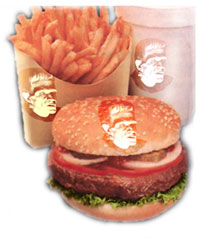-Guest Columnist-

Fast-food to hell (FCN)
Who will feed the world’s hun-gry, “Frankenfood” or “Mad Cows”?
In Frankenfood’s corner, we have Jonathan Rauch who, in an October 2003 article in The Atlantic Monthly magazine entitled “Will Frankenfood Save the Planet?,” raised a question about the problems and possible solutions of feeding a growing world population. He believes the problem is too little land and too many people, and the solution is more technology.
However, in a Sept. 9. 2003 article in The Final Call newspaper entitled, “Six million go hungry in land of abundance,” Marcela Valente puts the problem of hunger not with technology or a lack of productivity, but income distribution. Ultimately, she considered it a political or economic problem that requires a political or structural solution.
Ms. Valente quotes Patricia Aquirre of the Health Ministry’s Maternal-Infant Health division as saying, “In Argentina, the problem is not one of availability of food, but of being able to afford it. If the distribution of wealth were more equitable, there would be enough food for everyone.”
The article points out that the middle and upper classes in Argentina have access to at least 250 different food products, while the diet of the poor includes only 22 “affordable” items.
To complicate matters, the once rich nation of Argentina has been transformed into an economy where 54.7 percent of the population has fallen into poverty. This collapse happened in a relatively short period of time, while the nation was still a world leader in the export of beef, corn, wheat and soybeans.
Although Argentina already produces an economic surplus, Mr. Rauch’s article would give one the impression that Argentina could produce its way out of hunger by introducing Frankenfood. (If only the “environmentalists” would get out of the way and allow our beneficent scientists and agribusiness industry to bring the world into the new biotech revolution, the success of the “Green Revolution” could be multiplied.)
Although Mr. Rauch admits that he is “agriculturally illiterate,” he writes a six-page article to convince the world to lower its shield of skepticism toward an agricultural industry run by–as Minister Farrakhan has described–”merchants of death.”
Before Mr. Rauch gives a free hand to the “scientists” working in their laboratories, he should evaluate those countries that supposedly benefited from the “Green Revolution.” The term “Green Revolution” was coined in the 1960s to describe the adoption of new high-yielding varieties of wheat, rice and corn. However, these “modern varieties” produced more than the traditional varieties, mostly because they were more responsive to irrigation and petrochemical fertilizers.
In a March 2000 article called “Lessons from the Green Revolution” found on the Food First website, Peter Rosset, et al., writes:
“By the 1970s, the term ‘revolution’ was well deserved, for the new seeds–accompanied by chemical fertilizers, pesticides and, for the most part, irrigation–had replaced the traditional farming practices of millions of Third World farmers. The total food available per person in the world rose by 11 percent from 1970 to 1990. However, in South America, per capita food supplies rose almost 8 percent per person, but the number of hungry people also went up by 19 percent. Commercial farms expanded, running small farmers off of the land and into the cities, where they could not find adequate incomes and, therefore, could not afford to buy adequate food.”
After the crops were grown, most of the population in these countries was too poor to purchase these commercially grown crops, so they were exported to the developed world, especially Europe. Therefore, the “Green Revolution” provided a source of cheap food for Europe, while addicting Third World countries to purchase inputs provided by Europe, America and their allies.
Now, Frankenfood adds a new wrinkle to this game of monopoly. The new genetically engineered “miracle” crops will be produced with patented seeds that will be illegal for the farmers to save and store for next year’s planting. The farmers then will be completely at the mercy of the multinational biotech. Imagine a world where one or two companies control all of the seed.
Technically, if the seed is patented, then its offspring belongs to the patent holder, since the fruit is also filled with the patented genes. Therefore, if the seed company wanted to exert its “rights” to the limit, it could dictate the buyers of “their” crop. If you decided to eat “their” crop without their permission and they found traces of the patented gene in your gut, then they could charge you with destroying their property. Frankenstein is laughable compared to the past exploits and future plans of these new test tube-slinging cowboys.
The most technically literate societies, such as Europe and Japan, are deathly against Frankenfood. However, America is still trying to use the World Trade Organization to shove it down the throats of Europe and Japan, while she uses Africa for her genetic refuse.
These same scientists and food companies that create Frankenfood introduced “mad cow” disease to the world, by feeding cows to cows, then to you. Cows naturally get their protein and energy from eating vegetation and not meat.
It takes 10 times more land to produce the same amount of food energy derived from beef than it does to grow beans that would provide that same energy. If America was concerned about relieving hunger, then let her give up “mad cow” burgers. She might even lose a few inches around the waist, as she releases the land from beneath the burden of her gluttonous desire for meat and allows it to be used to feed a “hungry world.” But it seems that she would rather poison the land, like she poisoned the cows, and ultimately herself.
What ever happened to Frankenstein anyway? Remember, Frankenstein was the scientist who made the monster, so who was the real “monster”?
(Dr. Ridgley Muhammad is manager of Muhammad Farms in Georgia.)












